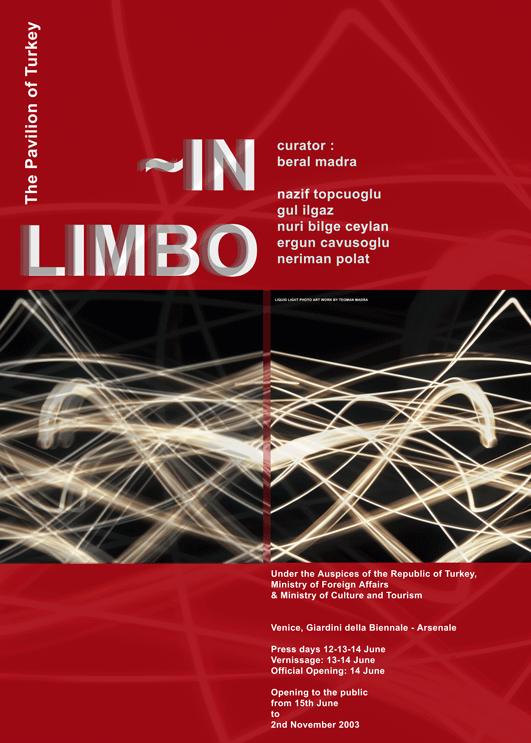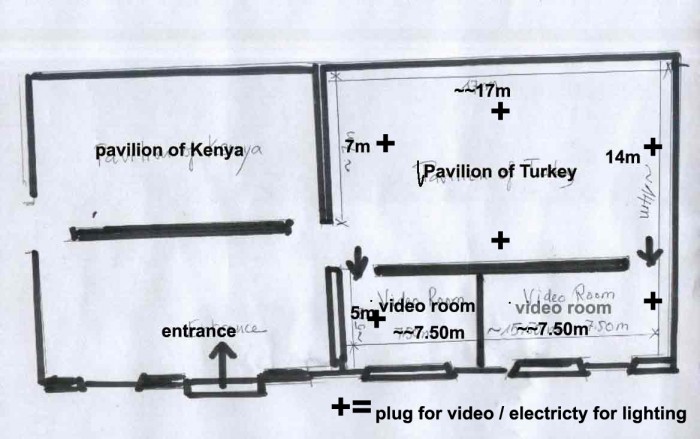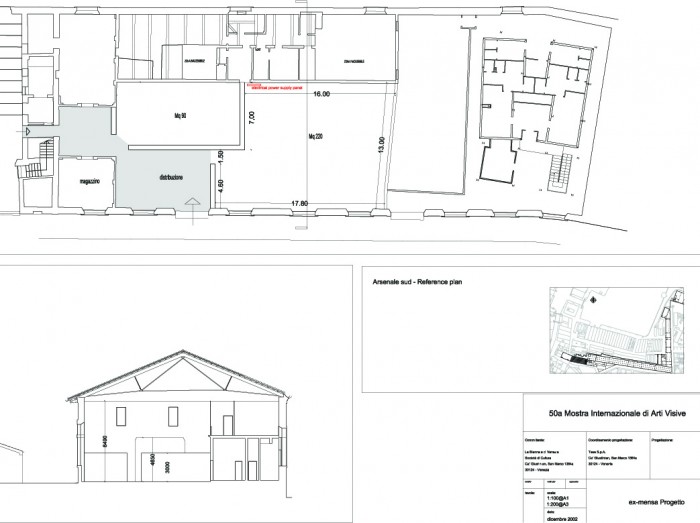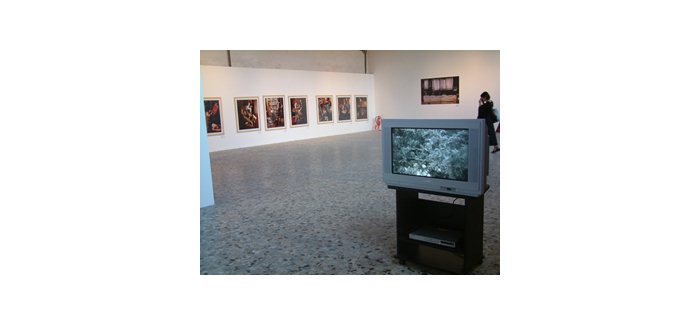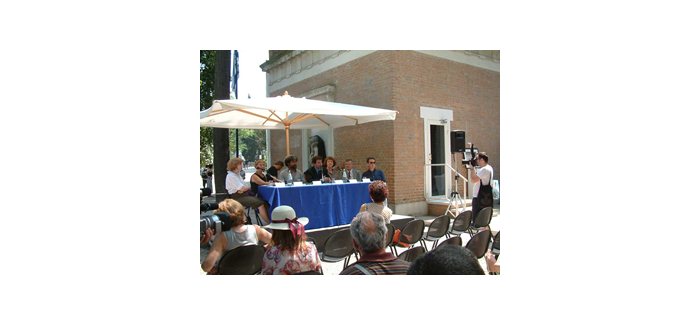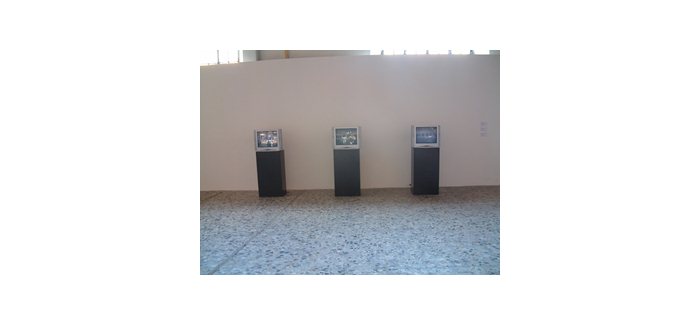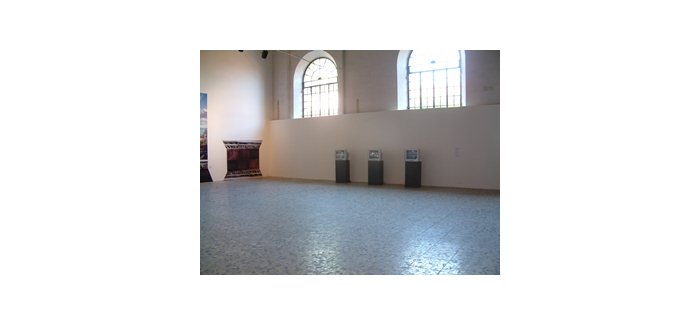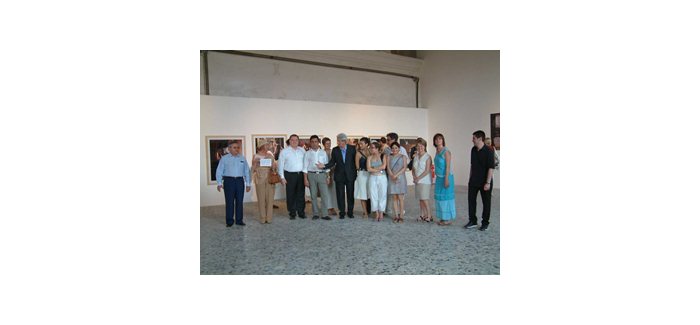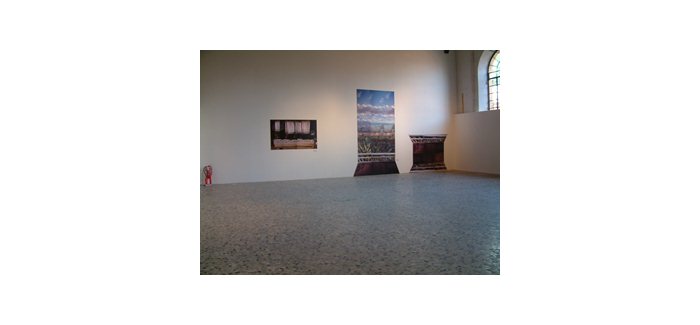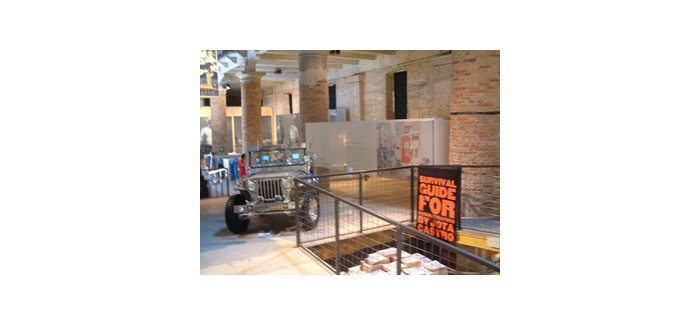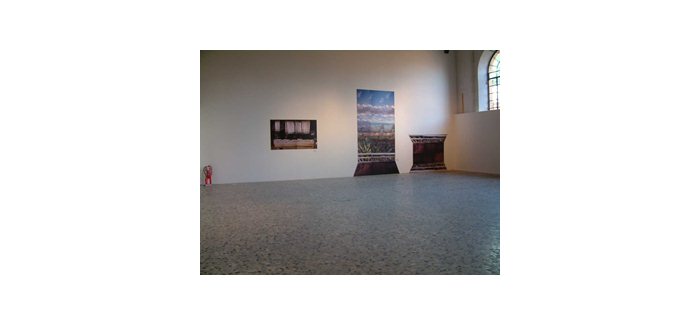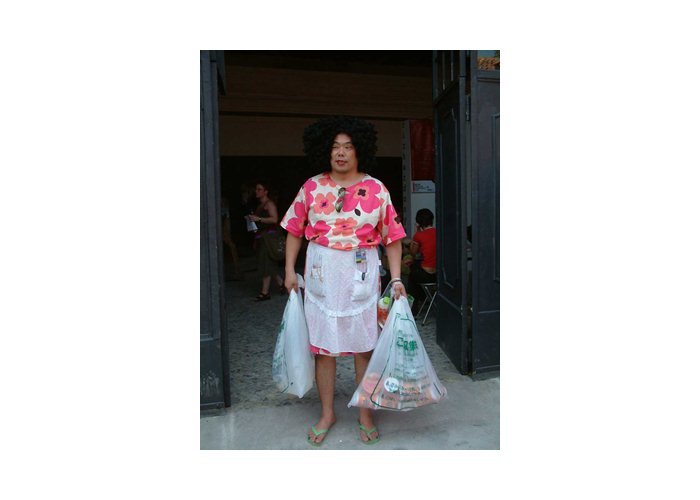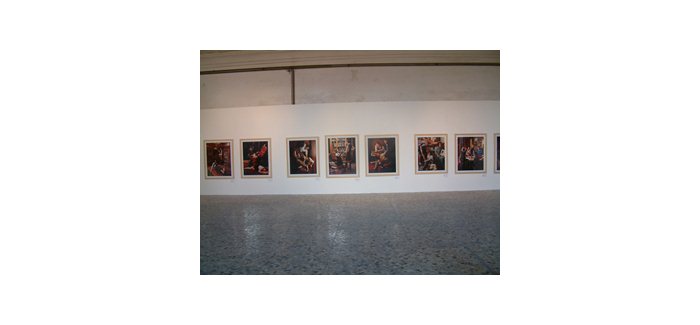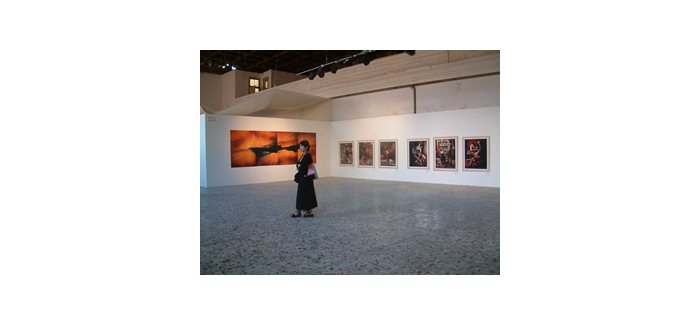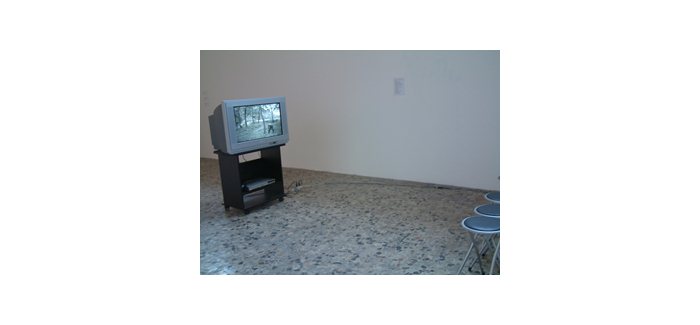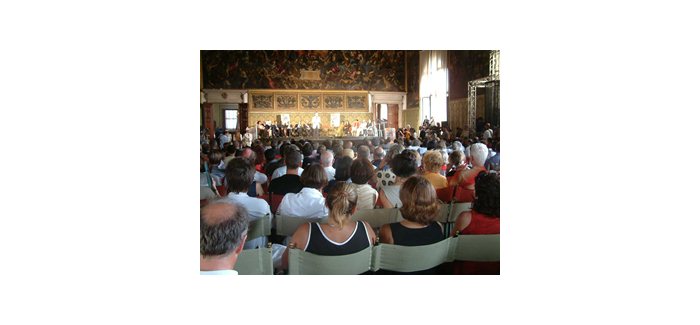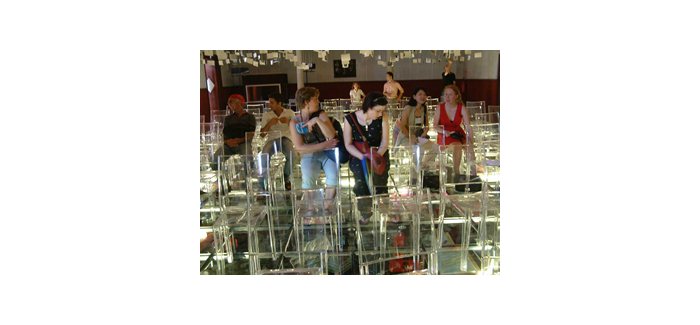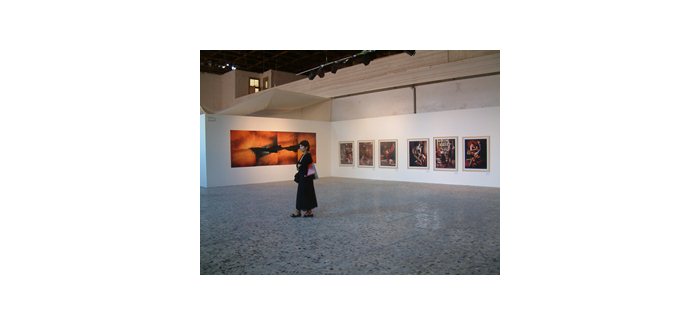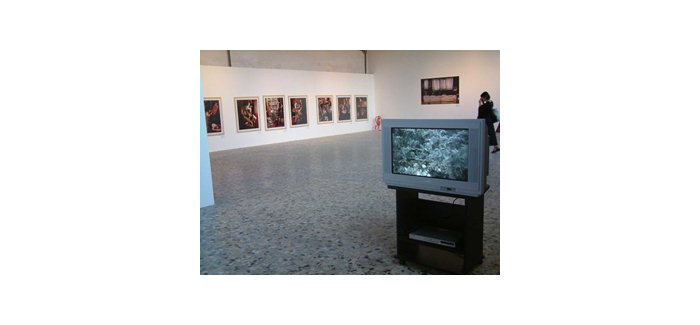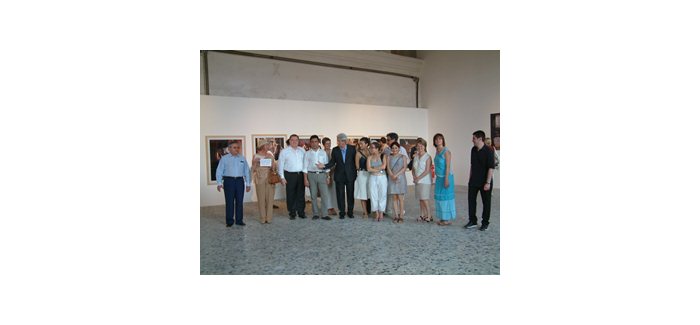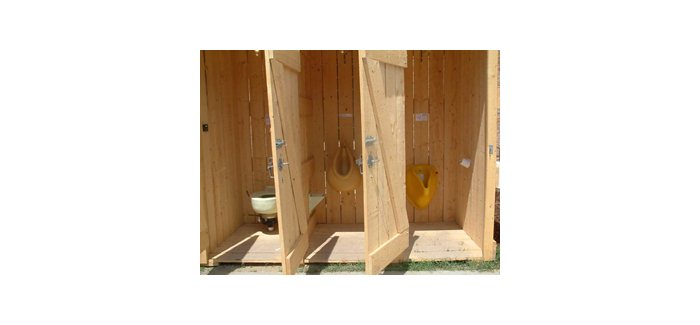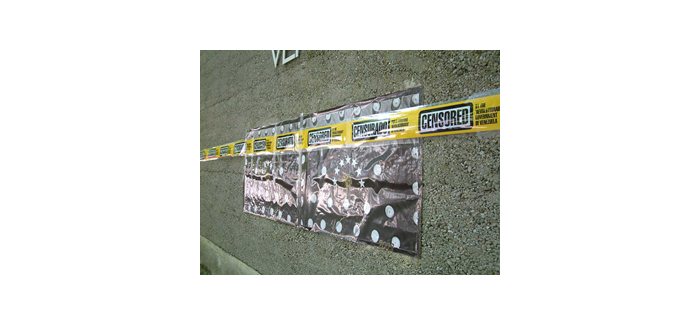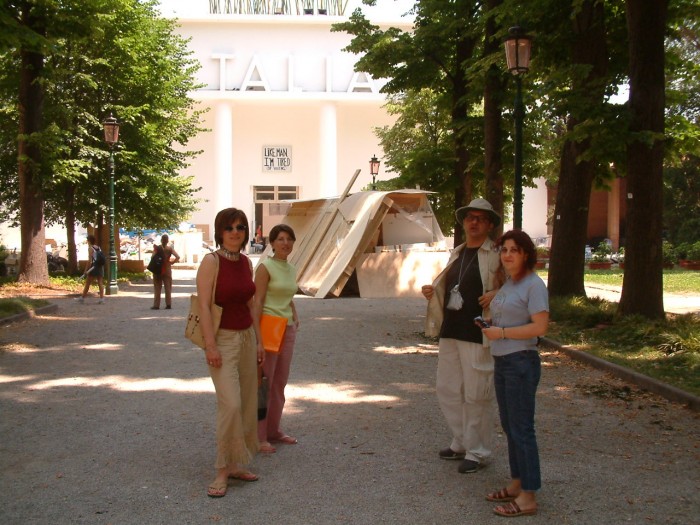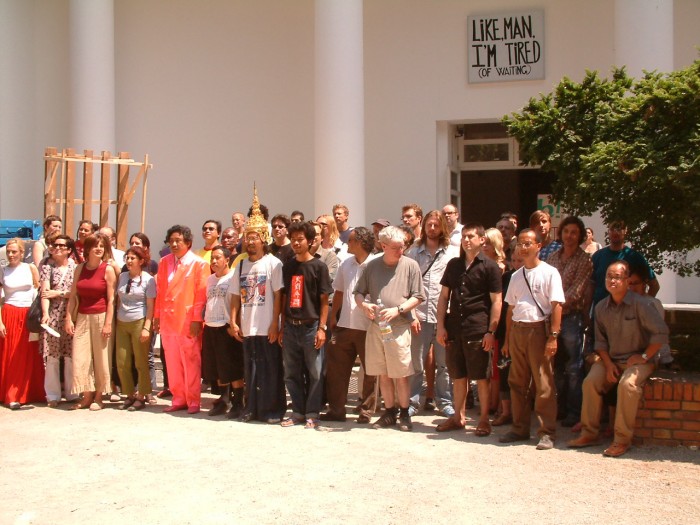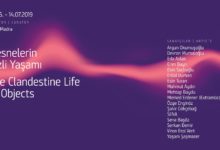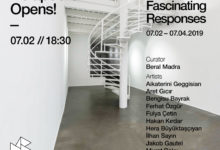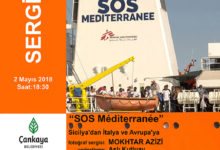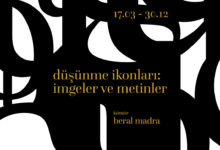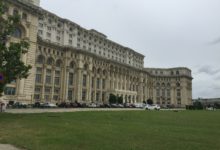VENEDİK BİENALİ 50. ULUSLARARASI SANAT SERGİSİ
15 Haziran-2 Kasım 2003
TÜRKİYE PAVYONU (ARSENALE)
Açılış: 13 Haziran, 2003, Cuma 16.30
IN LIMBO
Nuri Bilge Ceylan, Ergin Çavuşoğlu, Gül Ilgaz, Neriman Polat, Nazif Topçuoğlu
Küratör/Komiser: Beral Madra
T.C. Dışişleri Bakanlığı ve Kültür ve Turizm Bakanlığının katkılarıyla
Türkiye Pavyonu sponsoru TOFAŞ A.Ş.
Türkiye Odalar ve Borsalar Birliği (TOBB), Profilo Telra Elektronik San. ve Tic. A.Ş., Aksoy Grafik Dizgi Matbaacılık A.Ş., Milano Türk-İtalyan Dostluk Derneği, Cognis Kimya A.Ş. ve Organik Holding A.Ş. ve Alitalia’nın katkılarıyla
1895 yılında kurulmuş olan Venedik Sanat Bienali bu yıl 50. yıldönümünü kutlayacaktır. Kenya’dan Yeni Zelanda’ya, İran’dan İspanya’ya yaklaşık 75 ülkenin katıldığı Bienal, 15 Haziran-2 Kasım 2003 tarihleri arasında düzenlenecektir.
Venedik, turizmi ve kültürü birleştirmiş bir kenttir ve İtalya’nın küresel kültür içindeki imajının merkezidir. Küreselleşme sürecinde Venedik Bienalleri, Avrupa Birliğinin kültür politikasının sanatsal olduğu kadar kuramsal ağırlıklı forumudur.
Altı ay boyunca kitlesel izleyici çekenVenedik Sanat Bienali, sadece sanatseverlerin değil, günceli anlamak isteyen, günü sorun, kaygı, umut ve beklentilerini ölçmek isteyenlerin öncelikle görmeleri ve yaşamaları gereken bir ortamdır. Nitekim, gelişmiş ekonomilerin belli başlı kural koyucuları için bu durum geçerli olduğu için, dünyanın önde gelen mimar, tasarımcı, moda tasarımcıları veya pazarlamacıları, “trend setter”lar, Venedik Bienali ve benzerlerini kaçırmamak için özel gayret sarfetmektedirler.
Türkiye, 50. Venedik Bienali’ne Nuri Bilge Ceylan, Ergin Çavuşoğlu, Gül Ilgaz, Neriman Polat ve Nazif Topçuoğlu’nun fotoğraf ve video yapıtlarının yer aldığı, kavramı serginin küratörü Beral Madra tarafından oluşturulan “In Limbo” başlıklı bir sergi ile katılıyor. Sanatçılar, kurulma aşamasındaki Uluslararası Eleştirmenler Derneği (AICA Türkiye) kurucu üyeleri Beral Madra, Ahu Antmen, Ali Akay, Evrim Altuğ, Serhan Ada, Esra Aliçavuşoğlu, Levent Çalıkoğlu, Haşim Nur Gürel, Cem Erciyes’in çalışmaları sonucunda davet edildiler. Türkiye Pavyonu, Bienalin ana mekanlarından Arsenale’de, pavyonu olmayan ülkeler icin hazırlanan binada 220m2’lik mekanda yer alacak ve serginin açılışı 13 Haziran 2003′ deyapılacaktır.
“In Limbo”, Venedik Bienali’nin bu yılki küratoru Francesco Bonami’nin sergi kavramında belirttiği “düşlerin” üreticisi olan sanatçıya ve etkisi belirleyici olan kitlesel izleyiciye gönderme yapan bir başlık.
Latince “limbus” (eşik) sözcüğünden türemiş olan, uluslararası yazında ve kitle kültüründe “hiçbir yerde olmama”, “ortada kalma” gibi anlamlar taşıyan “In Limbo”, izleyicinin sanat yapıtıyla karşılaştığı anın algı özelliğini, sanat sisteminin içindeki farklı eşikleri, sınırları ve alanları işaret ediyor.
Cehennemin eşiğindeki bölge, ne cehenneme ne de cennete giremeyen ruhların kalakaldığı yer ya da büyük yanılgılar ve karmaşalar anlamı da taşıyan “In Limbo”, içinde yaşadığımız sürekli krizler durumunu ve savaş manzaralarını da tanımlıyor.
Günümüzde küresel siyasal/ekonomik/kültürel sahnede, sanatçıların ve izleyicilerin düşleri ve karabasanları bir görsel/kavramsal kriz döngüsüne kilitleniyor. Küreselleşme sürecindeki değişimler, ülkeler arasında ilişkilerde sürmekte olan çatışkılar ve bunlarin elektronik medyaların müdahalesiyle kitlelere yansıtılması, krizlerin birbirini izlemesine neden olurken, etkileri günlük yaşamın en ince ayrıntılarına değin sızıyor, yaşamlar insanların iradesi dışında yeniden biçimlendiriliyor. Bu süreçte, sanat yapıtlarında gündelik yaşamın görüngüleri konu olmaktan öte, bir neden oluyor. Sanatçı, güven duygusuyla ve incelikli düşüncesiyle, günlük yaşamın 24 saatini irdeliyor, söküyor, kuruyor ve krizlerle hesaplaşma alanları açıyor. İzleyiciler, kendilerine ait alanların irdelenmesine ve yeniden kurgulanmasına tanık olurken, olumlayan ya da yadsıyan tüketiciler olarak işlevlerine sahip çıkmaya çağrılıyor.
“In Limbo” sergisindeki sanatçıların işlerinde bu karşılıklı etkileşimin, görsel/düşünsel üretimin/tüketimin işaretleri, çağrışımları, metaforları izleniyor.
Nuri Bilge Ceylan’in 1995 tarihli Koza adlı kısa filmi, yönetmenin bütün filimlerinin uslubunu ve kavramlarını içeren bir alıntı ya da bir dipnot olma özelliği taşıyor. Kırsal alana özgü zamanın ve bir yaşam öyküsünün kesitleri birbiri içine geçen görüntü dilimleriyle izleyiciye sunuluyor. Elektronik medyanın çözümsüzlük içeren resim sellerine karşın bu film izleyiciyi zamanın kısalığı ve uzunluğu arasında bir seçim yapmaya yöneltiyor.
Londra’da yaşayan, 1996’dan bu yana Istanbul’da özellikle kimlik irdelemeleri ve kent dokuları yansıtan fotograf işleriyle tanınan Ergin Çavuşoğlu videolarında kamerayı bir gözetleme aygıtı gibi kullanarak, heterojen bir kentsel doku içinde insan davranışlarını izliyor. Görüntüler, olağan gibi görünen/gösterilen ilişkiler ve davranışlara bir kuşku gölgesi düşürüyor, izleyiciyi çelişkileri fark etmeye ve seçenekleri aramaya yöneltiyor.
Kendi yaşamından kesitler, yaptığı performansların belgeleri ya da yaşadığı kentin coğrafyası içinde toplumsal/kültürel gerçeklerinin soyutlamaları olarak sunduğu fotograflarında Gül Ilgaz, izleyiciye bireyden topluma, özelden genele, yanılsamadan gerçeğe, olağandan çelişkiye doğru algı süreçleri ve karşılaştırma işaretleri gönderiyor.
Neriman Polat’in fotoğraf ve videoda yalın ve özlü bir dil, dingin ve akıcı bir uslup sunuyor. Farklılıkların sınıflandırılması, benzerliklerin farklılığının gösterilmesi gibi görüntüleri kara mizah ile gözlemliyor. Sergideki bilgisayarda işlenmiş fotoğrafında oryantalist günes batışı resimlerini çağrıştıran post-romantik manzara, kentin çelişkili mimari dokusunun görüntülerinin oluşturduğu kriz manzarasıyla yön değiştiriyor.
Nazif Topçuoğlu’nun klasik resim kompozisyonu ve anlatım dilini kullanan kurgu fotoğraflarında ülküselleştirilmiş bir yakın geçmişin simulasyonu ile ilgili düzenlemeler izleniyor. Özenle seçilmiş ve düzenlenmiş “geleneksel” mekanlarda, 60’lı/70’lı yılların giysilerini ya da farklı kimlikleri yansıtan giysileri taşıyan, arzu nesnesi yeni yetme kızlar, bilgi ve bilgilenme iktidarının ve belleğin geleneksel simgeleri olan kitapların ortamında bir yabancılaştırma işlemine sokuluyor.
90’lı yılların başından bu yana seçkin sergilerle çağdaş sanat üretimini uluslararası ortama sunan Türkiye’nin Venedik Bienaline bu sergiyle katılımı, gerek Avrupa Birliğine adaylık süreci, gerek yurtdışı tanıtım açısından, büyük önem taşıyacaktır.
**************************************************************************
La Biennale di Venezia 50th International Art Exhibition
15th June-2nd November 2003
The Pavilion of Turkey (Arsenale)
Opening: 13th June, 2003, Friday 16.30
IN LIMBO
Artists: Nuri Bilge Ceylan Ergin Çavusoglu Gül Ilgaz Neriman Polat Nazif Topçuoglu
Curator/Comissar: Beral Madra
Under the auspices of the Ministry of Foreign Affairs and Ministry of Culture and Tourism
The sponsor of the Pavilion of Turkey is TOFAS AS.
Union of Chambers and Commodity Exchanges of Turkey (UCCET), Profilo Telra Elektronik San. ve Tic. A.S., Aksoy Grafik Dizgi Matbaacilik A.S., Turco-Italian Friendship Association in Milano, Cognis Kimya Turkey and Organik Holding A.S., Alitalia and Kodak are the contributing sponsors.
At the 50th Biennale di Venezia, Turkey presents five artists (Nuri Bilge Ceylan, Ergin Çavusoglu, Gül Ilgaz, Neriman Polat, Nazif Topçuoglu) of the current mercurial art scene of Istanbul in an exhibition entitled “In Limbo”, curated by Beral Madra.
The title “In Limbo” is a reference to the producer of the dreams, the artist and to the anonymous, yet omnipotent viewer, as described in the concept of F. Bonami. It also points to the art appreciation in general, at the moment of encounter with the artwork or within the different layers/ hierarchies of the art system. In the current global political and cultural scene, dreams of the viewer and of the artists are intersecting in a circuit of visual and conceptual crisis, not only owing to “globalisation”, but also to ongoing conflicts and their transmission through the electronic media. Yet, in paradox, the conflict is not breeding itself in the field of art but on the everyday life of the viewer and the artist.
The concept, “limbo”, which means a region on the border of hell, a place of souls which do not go to heaven or hell, a state of neglects, oblivion and complication clearly defines the currently experienced “warscape”. Within this “warscape” and the supremacy of the corporate economy and global politics, the everyday life of the artist and the viewer makes all the difference in art. The artist, aware of the eminence of it, approaches these twenty-four hours in detail, itemises and particularises the facts with his/her inevitable sophistication and self-contempt. Whoever gives him the right to intervene into the minute details of the common life, and the authority to cry out his message to the world from a headland, also consumes it with the same empathy or apathy.
ARTISTS
Nuri Bilge Ceylan’s films guide the viewer throughout the everyday life and psychology of the small town individual, but disclose the social conflicts of a population entrapped in phases of transition between past and present. Cocoon is an excerpt or citation, related to his concept of his past and recent films and gives a perspective into the land as the background of the global city, as the source of psychology of the current city-individual.
Ergin Çavusoglu’s current artwork consists of photography and video. Through the images, personal and cultural identities are negotiated and located in urban everyday life. The excessive use of the voyeuristic character of the camera highlights the ambiguous behaviour of individuals in their street existence.
Gül Ilgaz’s photography work is largely authobiographical, yet it also offers the viewer a key to open a discussion on common everyday realities and the ambiguity of representation. She juxtaposes illusion and reality, subjective and objective, individual and social to give the viewer an opportunity to exercise his/her perceptive skills.
Neriman Polat’s vocabulary with photography and video is lucid, calm and substantive. Itemisation, classification and arrangement of the facts and events she is observing and inquiring is ironic and amusing. In her present digital photography she displays a “warscape” within an orientalistic landscape, both constructed with the elements of the natural and urban environments.
Time, memory and loss is the basic concept of Nazif Topçuoglu’s work. He reconstructs dubious and tainted images of an idealised past with the intention to defeat the transience of people and things in general. Currently, he produced images of young girls – in ambiguous retro positions
********************************************************************************
CONCEPT TEXT
IN LIMBO
Twenty-four hours in the life of the viewer
In the 50th Biennale di Venezia Turkey presents five artists of the current mercurial art scene of Istanbul. In the map of the international contemporary art, Istanbul is one of the major terminals due to its global trading city identity since the late 80’s, when the globalisation, corporate culture, electronic technology and media power hit the region.
Istanbul is a historical city, but was never a classical city with a defined centre. Bosphorus and the Golden Horn divide the city into three almost independent parts; a phenomenon, which bestowed the city with visual and cultural abundance. Yet, the immigrations and the global economy rapidly transformed the city into a multi-centred and de-centred mega-space and into an endless collage of urban, suburban and rural settlements. Layers of macro and micro cultures co-exist within the same districts. Layers of prevalent traditional culture, resistant immigrant culture and the dominant corporate culture are in ambiguous alliance. ” Identity” and “otherness” are floating/drifting concepts; “others” are present everywhere, not only because of the immigration, but because the culture and the everyday-life of the “others” constitute a crucial part of the so-called corporate economy. The city concentrates on diversity in a micro-level, even though the globalisation process has introduced a strong unifying corporate culture, dominant in the new developed business areas of the vast city. A current amalgam of rural cultures with sophisticated international culture is making up a redundancy and multiplicity of “emergency identities” that accordingly unfolds its new forms and dimensions.
This is the architectural/urban/social space where the artists of this show produce their works.
The heterogeneous art productions since the beginning of the 90’s, portray the city as an integral part of the micro and macro narratives, representations, simulations and metaphors and as a mirror of the totality of Turkey. In the paintings, photographs, videos and installations of a large number of artists we can trace, recognise and perceive this amalgam as the reason of the work, while not directly the theme or the subject.
Turkey, with its socio-political and economical conflicts, is one of the most enticing country of this world; and this has been elaborately expressed in many ways through different art forms. We know that, after the erosion of traditional and modern worldviews and values things are different now; artists do not produce simple beautiful, sublime works for the eulogy of their country. The ideologies of art maintain their function as being a part of social life and the critical conscious of the society. The artists openly or metaforically scrutinise the situations in which patterns for orientation and action of the past no longer work. They are the ones who find new options and actions to provide answers for everyday life conflicts and major emergencies. With Paul Vanguiem ‘s words “Everyday life always produces the demand for a brighter light, if only because of the need which everyone feels to walk in step with the march of history. But there are more truths in twenty-four hours of a man’s life than in all the philosophies.”
The title “In Limbo“is a reference to the producer of the dreams, the artist and to the anonymous, yet omnipotent viewer, as described in the concept of F. Bonami. It is also pointing to the art appreciation in general, at the moment of encounter with the artwork or within the different layers/ hierarchies of the art system. Within the current global political and cultural circumstances, dreams of the viewer and the artists are intersecting in a circuit of visual and conceptual crisis, not only owing to the so called “globalisation”, but also to the ever present war and its transmission through the electronic media. Yet, in paradox, the conflict is not breeding itself on the field of art but on the everyday life of the viewer and the artist. The concept, “limbo“, which means a region on the border of hell, a place of souls which do not go to whether heaven nor hell, a state of neglects, oblivion and complication clearly defines the currently experienced “warscape”. Within this “warscape” and within the supremacy of the corporate economy and global politics the everyday life of the artist and the viewer makes all the difference in art. The artist, aware of the eminence of it, approaches these twenty-four hours in detail, itemise and particularise the facts with his/her inevitable sophistication and self-contempt. Whoever gives him the right to intervene into the minute details of the common life, and the authority to cry out his message to the world from a headland, also consumes it with the same empathy or apathy.
Yet, the metaphorical responses of the artists are most of the time private, subjective, hermetic and closed to direct access; as if the viewer needs a password to enter. The viewer can easily feel confused, frustrated and slightly overwhelmed by them. The password gives him/her the power to knowledge and information, provide him/her with identities and ideologies or it prevents him/her know the truth and the virtue.
Nuri Bilge Ceylan‘s films guides the viewer throughout the everyday life and psychology of the small town individual, but discloses the social conflicts of a population entrapped between past and present. Cocoon is a kind of excerpt or citation, related to his concept of his past and recent films and gives a perspective into the land as the background of the global city, as the source of psychology of the current city-individual. In Cocoon the viewer will encounter the serene, refined movement of the camera almost in real time tempo, lingering on the constituents of the dramatic moments. The film is almost a mowing photography. Ergin Cavusoglu‘s current artwork consists of photography and video. In figurative compositions, architecture, and urban landscapes he explores the relationship between humans and their environment, the multiplicity, diversity and ambiguity of the social landscape. Through the images personal and cultural identities are negotiated and located in urban everyday life. The images take ordinariness to the point of ambiguity, forcing the viewer to dig deeper and draw their own conclusions. Gül Ilgaz’s siginificant work (2002), almost bird’s eye view, fragmented digital image of Bosphorus is based on a phrase often asserted when there is a dilemma, as manifested in the title of the work: “Between two lands and a river; we find ourselves in the middle of this geography, that penetrates into our genes”. It thoroughly explains the reason of the work; whoever lives in this city will have experience the dilemma of being on Eastern/Asian or Western/ European territory continuously. On the other hand Ilgaz’s work is a fragmentation reflecting the exhausted gaze of the inhabitants of this city; exhausted of dealing with the collisions between the history, the modernity and the post-modernity. Neriman Polat‘s vocabulary with photography and video is lucid, calm and substantive. Itemisation, classification and arrangement of the facts and events she is observing and inquiring is ironic and amusing. She is utilising the documentary material as “case stories” to examine social realities and the relation between the individual and public, between genders, between similarities and differences. Time, memory and loss is the basic concept of Nazif Topçuoğlu‘s work. He reconstructs dubious and tainted images of an idealised past with the intention to defeat the transience of people and things in general. His recent work series represent an ongoing fascination with certain supposedly taboo subjects in a traditional society and how some of these have gained a prominent position among the primary occupations of contemporary art. Hence, he produced images of young girls dealing with books, whit strategic details implicating knowledge and information.
Beral Madra/ February-April 2003
***************************************************************************
The viewer in Turkey
Artworks do not only provoke its viewers in mental and emotional ways but also elevate them to a distinguished status in socio-political sense. The contemporary viewer is no longer the patron of the arts as in the old times, yet still, is a privileged person. In the contemporary case, it is the act of involvement in an art event which grants privelage. Despite the viewer is only a passive participant of the artistic activity, she/he overcomes her/his ordinariness by being a part of the art process and feels intellectually and socially privileged. It is the artwork and the art exibition which underlines and confirms the high taste, the critical capacity and the unfulfilled creativity of the viewer.
The viewer observes contemporary artworks, not only as a means to enjoy the sense of challenge, and to trancend her/his sense and perception of everyday reality but also as a means to trancend her/his social position. Finally, the viewer, regards contemporary artworks as her/his tools of political criticism. The viewer feels entitled to be a contrarian through the protest of the artist. Art exibition or art event, in this sense, becomes a platform of social and political challenge, on behalf of the viewer along with the artist.
As artwork and art event have their own reality, they have their own community. The viewer and the artist are no equal partners, nevertheless, the viewer permanently underlines her/his essentiality by her/his mere presence. The art viewer in Turkey, is not very different from the rest of the world, or West of the world. Nevertheless, the viewer in Turkey, perhaps feels more privileged since contemporary art itself, is something very Western and Westernization is an elite quality in Turkey. Some even claimed that contemporary art, in the beginning was rather a medium of Westernization, and as such, first of all, could be defined by its elitist quality. This notion is gradually changing, as the contemporary artists are focusing in their works more and more on the different aspects of culture and life in Turkey, rather than portraying its Western face and promoting the Western style. The permanent conflict and tension, resulting from diverse aspects of culture and life makes Turkey, increasingly become a very rich and fertile ground for artistic manipulation. Enormous discrepancies among social classes, life styles, geographical regions, sub-cultures, as well as the differences and conflicts between Western/Eastern and secular/Islamic aspects of culture in Turkey turn to be a peculiar opportunity for someone like an artist who is disturbed by the order and the ordinary. Therefore, the most usual pace of everyday life, the ordinary chaos of twentyfour hours is full of provocation for the critical and creative gaze of the contemporary artist.
Nuray Mert/ April, 2003

